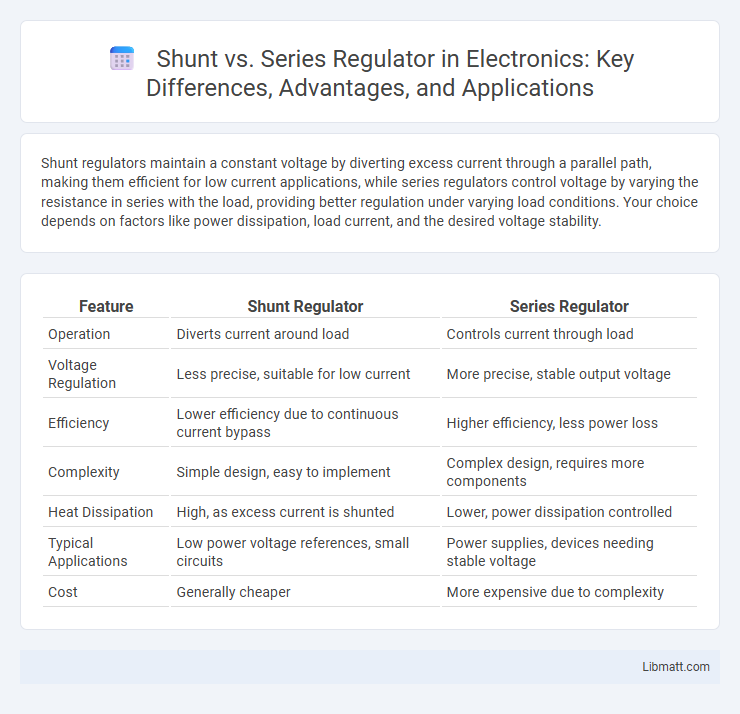Shunt regulators maintain a constant voltage by diverting excess current through a parallel path, making them efficient for low current applications, while series regulators control voltage by varying the resistance in series with the load, providing better regulation under varying load conditions. Your choice depends on factors like power dissipation, load current, and the desired voltage stability.
Table of Comparison
| Feature | Shunt Regulator | Series Regulator |
|---|---|---|
| Operation | Diverts current around load | Controls current through load |
| Voltage Regulation | Less precise, suitable for low current | More precise, stable output voltage |
| Efficiency | Lower efficiency due to continuous current bypass | Higher efficiency, less power loss |
| Complexity | Simple design, easy to implement | Complex design, requires more components |
| Heat Dissipation | High, as excess current is shunted | Lower, power dissipation controlled |
| Typical Applications | Low power voltage references, small circuits | Power supplies, devices needing stable voltage |
| Cost | Generally cheaper | More expensive due to complexity |
Introduction to Voltage Regulation
Voltage regulation is essential for maintaining a steady output voltage despite variations in input voltage or load conditions. Shunt regulators maintain voltage by diverting excess current through a parallel path, ideal for low-power applications due to their simplicity and low cost. Series regulators control voltage by adjusting the resistance in series with the load, offering better efficiency and regulation precision in medium to high-power applications.
What Is a Shunt Regulator?
A shunt regulator is an electronic voltage regulation device designed to maintain a constant output voltage by diverting current away from the load. It operates by placing a voltage reference and a transistor in parallel with the load, effectively shunting excess current to ground to stabilize voltage fluctuations. You can use shunt regulators in low-current applications where precision voltage control is essential despite varying input voltage or load conditions.
What Is a Series Regulator?
A series regulator is a voltage regulation device that maintains a constant output voltage by adjusting the resistance in series with the load, ensuring stable power supply despite input voltage or load variations. It operates by varying the series pass transistor's conductivity to regulate the voltage drop and minimize power dissipation. Compared to shunt regulators, series regulators offer higher efficiency and better performance in applications requiring precise voltage control.
Key Differences Between Shunt and Series Regulators
Shunt regulators maintain voltage by shunting excess current through a parallel diode or transistor, offering simplicity and better voltage regulation for low current loads. Series regulators control voltage by varying the resistance in series with the load, providing higher efficiency and better performance under varying load conditions. Key differences include their configuration, current handling capability, efficiency, and suitability for high or low power applications.
Working Principle: Shunt Regulators
Shunt regulators maintain a constant output voltage by diverting excess current through a parallel path, effectively shunting current away from the load when voltage exceeds a set threshold. The regulator uses a reference voltage and a control element, commonly a transistor, to adjust the shunt current and stabilize voltage. This design allows for simple voltage regulation but is less efficient compared to series regulators due to continuous current flow through the shunt element.
Working Principle: Series Regulators
Series regulators operate by placing a transistor in series with the load, adjusting its resistance to maintain a constant output voltage despite variations in input voltage or load current. The feedback mechanism continuously monitors the output voltage and modulates the transistor's conduction to compensate for any changes, ensuring stable power delivery. Your devices benefit from this precise control, resulting in efficient voltage regulation and reduced power dissipation compared to shunt regulators.
Advantages of Shunt Regulators
Shunt regulators offer simplicity and cost-effectiveness, making them ideal for low-power applications where precise voltage control is not critical. They provide excellent voltage stabilization by diverting excess current, which enhances the reliability of your electronic circuits under varying load conditions. Their ability to respond quickly to transient changes ensures consistent performance without complex circuitry.
Advantages of Series Regulators
Series regulators offer superior voltage regulation and efficiency by maintaining a constant output voltage regardless of input voltage fluctuations or load changes. They produce less heat compared to shunt regulators, resulting in better thermal management and longer component lifespan. Their ability to provide stable and low-noise output makes them ideal for sensitive electronic applications and power supplies.
Typical Applications of Shunt vs Series Regulators
Shunt regulators are commonly used in low-power applications such as voltage reference circuits, battery chargers, and small signal stabilization due to their simplicity and cost-effectiveness. Series regulators are preferred in medium to high-power applications like power supplies for microprocessors, communication devices, and automotive electronics because they provide better efficiency and load regulation. Your choice depends on the required power handling, efficiency, and the specific voltage regulation needs in your circuit design.
How to Choose the Right Voltage Regulator
Selecting the right voltage regulator depends on load current requirements and efficiency needs. Shunt regulators are suitable for low current applications due to their simple design and cost-effectiveness but tend to waste power as excess current is shunted to ground. Series regulators offer better efficiency and voltage stability under variable load conditions, making them ideal for higher current applications or when precise voltage regulation is critical.
Shunt vs Series regulator Infographic

 libmatt.com
libmatt.com